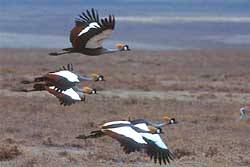 |
Ngorongoro Crater and Masai Village Thursday, August 24
|
| On this day, we planned to a game drive in the morning and then back to Crater Lodge for lunch so that we could go to a nearby Masai village after lunch. I wanted to get down in the crater early, so I went in one vehicle with our guide, Charles, and driver, Mohamed. |
| I was hoping to see a male lion so we headed out away from the picnic areas and rest of the crowds. Charles spotted a small flock of cranes ahead on the road so I asked him to stop so that I get my big lens ready. Just as we started up to move closer, the flock took off and I snapped the photo at the top of the page. |
| My most frustrating photographic experience happened here, though. As we watched the Serval, it was clear that he was hunting for rodents. Servals will jump in the air and pounce on their prey. He looked like he was about to do this, so I switched the motor drive on my camera to rapid shooting (five frames per second). I checked to make sure I had plenty of film. Sure enough, as I peered through the lens, the Serval pounced on his prey. I pushed the shutter release ... and nothing happened. I looked at the LCD display and the low battery indicator was blinking. Well, at least I'd seen him. |
| We went into one of the huts which are made from sticks, mud and dung,
and covered with a thatch roof. There are a few small holes in the huts
for light and ventilation, they were were quite hot and musty inside.
The huts are each about seven to eight feet across and twelve to fifteen
feet long. Inside are four rooms separated by stick walls. One room is
the kitchen which has a fire on the floor in the middle - the fire was
still smoldering in the hut I was in. Two rooms were used as bedrooms -
one for the man, the other for the woman and children. They sleep on low
beds made from leather. The fourth room near the entrance was where the
goats and baby calves spent the night. It must get fairly cozy in there
at night.
In the center of the village was a pen where the cows are kept at night. The huts surround the pen to ward off the lions. The lions have become deathly afraid of the Masai warriors since in the past the warriors killed many of them. Whenever a lion sees a Masai warrior on foot (wrapped in his traditional red kanga), the lion will take off in a run away from the Masai. |
| The visit Masai village was fascinating and well worth the excursion, but we all felt a little sorrow for the conditions in which the children live, particularly the flies everywhere. |